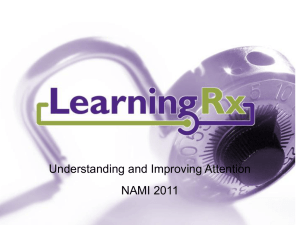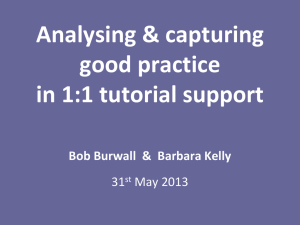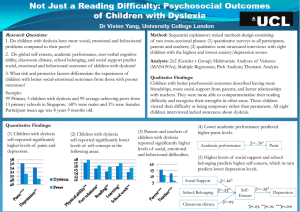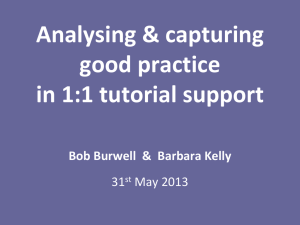Research Journal of Applied Sciences, Engineering and Technology 9(5): 365-373,... ISSN: 2040-7459; e-ISSN: 2040-7467
advertisement
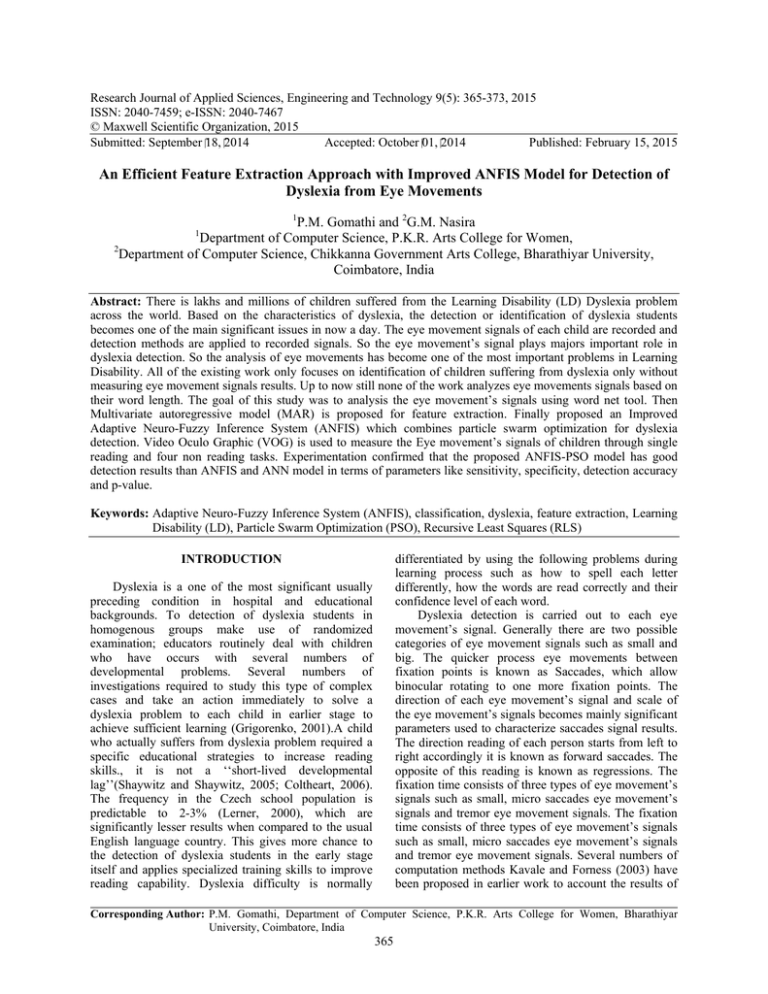
Research Journal of Applied Sciences, Engineering and Technology 9(5): 365-373, 2015
ISSN: 2040-7459; e-ISSN: 2040-7467
© Maxwell Scientific Organization, 2015
Submitted:
September 18, 2014
Accepted: October 01, 2014
Published: February 15, 2015
An Efficient Feature Extraction Approach with Improved ANFIS Model for Detection of
Dyslexia from Eye Movements
1
P.M. Gomathi and 2G.M. Nasira
1
Department of Computer Science, P.K.R. Arts College for Women,
2
Department of Computer Science, Chikkanna Government Arts College, Bharathiyar University,
Coimbatore, India
Abstract: There is lakhs and millions of children suffered from the Learning Disability (LD) Dyslexia problem
across the world. Based on the characteristics of dyslexia, the detection or identification of dyslexia students
becomes one of the main significant issues in now a day. The eye movement signals of each child are recorded and
detection methods are applied to recorded signals. So the eye movement’s signal plays majors important role in
dyslexia detection. So the analysis of eye movements has become one of the most important problems in Learning
Disability. All of the existing work only focuses on identification of children suffering from dyslexia only without
measuring eye movement signals results. Up to now still none of the work analyzes eye movements signals based on
their word length. The goal of this study was to analysis the eye movement’s signals using word net tool. Then
Multivariate autoregressive model (MAR) is proposed for feature extraction. Finally proposed an Improved
Adaptive Neuro-Fuzzy Inference System (ANFIS) which combines particle swarm optimization for dyslexia
detection. Video Oculo Graphic (VOG) is used to measure the Eye movement’s signals of children through single
reading and four non reading tasks. Experimentation confirmed that the proposed ANFIS-PSO model has good
detection results than ANFIS and ANN model in terms of parameters like sensitivity, specificity, detection accuracy
and p-value.
Keywords: Adaptive Neuro-Fuzzy Inference System (ANFIS), classification, dyslexia, feature extraction, Learning
Disability (LD), Particle Swarm Optimization (PSO), Recursive Least Squares (RLS)
differentiated by using the following problems during
learning process such as how to spell each letter
differently, how the words are read correctly and their
confidence level of each word.
Dyslexia detection is carried out to each eye
movement’s signal. Generally there are two possible
categories of eye movement signals such as small and
big. The quicker process eye movements between
fixation points is known as Saccades, which allow
binocular rotating to one more fixation points. The
direction of each eye movement’s signal and scale of
the eye movement’s signals becomes mainly significant
parameters used to characterize saccades signal results.
The direction reading of each person starts from left to
right accordingly it is known as forward saccades. The
opposite of this reading is known as regressions. The
fixation time consists of three types of eye movement’s
signals such as small, micro saccades eye movement’s
signals and tremor eye movement signals. The fixation
time consists of three types of eye movement’s signals
such as small, micro saccades eye movement’s signals
and tremor eye movement signals. Several numbers of
computation methods Kavale and Forness (2003) have
been proposed in earlier work to account the results of
INTRODUCTION
Dyslexia is a one of the most significant usually
preceding condition in hospital and educational
backgrounds. To detection of dyslexia students in
homogenous groups make use of randomized
examination; educators routinely deal with children
who have occurs with several numbers of
developmental problems. Several numbers of
investigations required to study this type of complex
cases and take an action immediately to solve a
dyslexia problem to each child in earlier stage to
achieve sufficient learning (Grigorenko, 2001).A child
who actually suffers from dyslexia problem required a
specific educational strategies to increase reading
skills., it is not a ‘‘short-lived developmental
lag’’(Shaywitz and Shaywitz, 2005; Coltheart, 2006).
The frequency in the Czech school population is
predictable to 2-3% (Lerner, 2000), which are
significantly lesser results when compared to the usual
English language country. This gives more chance to
the detection of dyslexia students in the early stage
itself and applies specialized training skills to improve
reading capability. Dyslexia difficulty is normally
Corresponding Author: P.M. Gomathi, Department of Computer Science, P.K.R. Arts College for Women, Bharathiyar
University, Coimbatore, India
365
Res. J. Appl. Sci. Eng. Technol., 9(5): 365-373, 2015
various dyslexia types. The Dual Route Cascaded
(DRC) model (Ziegler et al., 2001) presumes that two
different categories of reading tasks are selfdetermining from each other to a different language.
The aim of this study focuses on the detection of
medicinal analytical difficulty among eye movement
signals and dyslexia. This problem is studied in several
works in literatures, though these methods should not
provide exact detection results since recorded eye
movement signals are not analyzed using specific
methods. In order to solve these issues the recorded eye
movement signals are analyzed using word length and
frequency effects in a teach reading disorder with word
net tool. Eye movement signals of each child are
recorded using Videooculographic technology. Totally
there are 76 students eye movement signals are
recorded using iView 3.0 videooculography systems at
the Department of Neurology. The recorded eye
movement signals are analyzed using wordnet tool, then
most important features for analyzing eye movement
signals are extracted using multiple autoregressive
models (MAR) and learning of extracting features for
dyslexia detection through improved Adaptive NeuroFuzzy Inference System (ANFIS) with PSO algorithm.
Finally measure the detection rate of dyslexia between
existing ANFIS model and Improved ANFIS model
from feature extraction results for each eye movement
signal.
information increases and its morphological complexity
also simultaneously increases (Bertram and Hyönä,
2003) at a time and which it is directly proportional
with more letters in word processing point of view. For
all the above specified reasons conclude that the word
length becomes one of the important part to analysis the
results of eye movements signals based on fixation
time.
Analysis of the eye movement’s signals becomes
one of the interesting research areas and the modelings
of information for eye movement’s signals are
straightforwardly associated with mental states of each
reader. The meaning of each word read by child is
measured by using eye fixations (Staub et al., 2010).
Eye movements are well-known to be there cognitivelycontrolled (Findlay and Gilchrist, 2003). It consists of
information about low-level behavioral examination of
interactive tasks (Terai et al., 2008) and well-matched
task to characterize the textual information acquisition
process throughout exploration tasks. Much of the
existing science information works concentrate an eye
tracking methods based on the number of eye fixations,
for example to discover which information is most
ranked in search results pages (Pan et al., 2007;
Brumby and Howes, 2008).
METHODOLOGY
Based on the investigation and learning researches
from earlier work, the assessment of eye movement’s
signals plays major imperative role in experimental
reading investigation. Our work majorly focuses on the
analysis of eye movement signals based on their
information reader by each child, since so since none of
the research work mainly focuses on the analysis of the
eye movement signals with word length their
corresponding frequency property. The major aim of
this study is to discover different sequential and spatial
parameter away from entire fixation time. The number
of fixation time is used to examine the word -based
performance period and neighborhood fixation pattern
is used to distinguish among the several learning
disorders for dyslexic detection. From this analyzed eye
movement’s signal from word net based similarity
measure to extract most important features such as
frequency and time domain features of eye movement
signals to perform dyslexia detection results using a
Multivariate Autoregressive Model (MAR). Proposed a
Improved Adaptive Neuro-Fuzzy Inference System
(ANFIS) with PSO algorithm for dyslexia detection.
Word length and lexical frequency become one of
the most significant factors are used to analysis the
results of eye movements. Word length verifies the
values of fixation time and measures the number of
fixation time for each reading along with the number of
words read by children. If the word length
becomes longer, more number of fixations are required
LITERATURE REVIEW
Learning Disabilities (LD) have been much
attracting the interest in various applications areas such
as scientific regulation, together with therapy,
neuroscience, psychology, knowledge and sociology.
Since learning disabilities are generally imagine and
understood if both becomes under the similar scientific
regulation, can offer facts for the complication under
different category (Kavale and Forness, 2003). In
earlier work several learning academic activities
(Kavale and Forness, 2003; Reid and Valle, 2004) have
been carried out to discover the dyslexia children who
have actually suffers from LD difficulty, the major
causes of the learning disability majorly affects the
following actions such as thinking, listening,
concentration and, mainly significantly.
The study of official disclosure (Ferri et al., 2004)
is used to identify the learning disability problem
adopted by the Saudi department of Education. Since, it
says that reading is a complex task that needs many
skills for its mastery. Therefore, identification of skills
for success reading is also very significant. Recently,
Behrmann et al. (2001) developed a word-based length
examination to detect the results of pure alexia. Pure
alexia is known as reading disorder that happen from a
low-level unimportant destruction in the graphematics
system detection of letter character. If the quantity of
366
Res. J. Appl. Sci. Eng. Technol., 9(5): 365-373, 2015
that contain x, y and both x and y, correspondingly.
x & 𝑦𝑦 is different word of children, N is a normalising
factor its value is greater than f(x) and f(y). The
semantic relatedness among two attributes words in the
same eye movement signal can be calculated by the
following equation:
to complete reading task. To measure the word length
of the eye movement signals in this study uses a
wordnet based similarity measure where each child's
word is considered as input from eye movement
signals. Each and every one of the children word length
is separated into two parts such as medium (Ziegler
et al., 2001; Lerner, 2000) and long letters (Staub et al.,
2010; Findlay and Gilchrist, 2003). Shorter word length
is not considered for analysis of eye movement signals,
since it consist of less fixation time with patients, it
becomes hard to analysis the eye movement signals
with less fixation time. Each and every one of the
child's eye movement signals words is compared by
measuring the similarity among words it the similarity
levels of each reader reaches medium at long time is
considered as dyslexia affected students.
WordNet, each meaning of a word from eye
movement’s readers is characterized by a unique
wordsense of the word and a synset consists of group of
wordsenses that having the similar meaning for eye
movement’s signal. It consists of two third of nodes in
WordNet it is known as synsets. Made following
assumption to analysis the eye movements signals using
wordnet with edge lengths of the shortest path:
•
•
•
•
𝑟𝑟𝑟𝑟𝑟𝑟(𝑐𝑐1 , 𝑐𝑐2 ) =
∑𝑛𝑛∈{𝑆𝑆(𝑐𝑐1 ,𝑐𝑐2 )−𝑠𝑠𝑠𝑠𝑠𝑠 (𝑐𝑐1 ,𝑐𝑐2 ) 𝑤𝑤𝑤𝑤(𝑛𝑛, 𝑝𝑝𝑝𝑝𝑝𝑝𝑝𝑝𝑝𝑝𝑡𝑡𝑡𝑡𝑡𝑡(𝑛𝑛))
where, S(c1 , c2 ) is the set of different nodes features in
the shortest path among c1 and c2 , that corresponds to
same user eye movement signal Sol(c1 , c2 ) is the set of
different nodes features in the shortest path without
parent, n represents the number of nodes considered by
S(c1 , c2 ).
Global information service Feature extraction based
on Multivariate Autoregressive Models (MAR): The
most significant features of dyslectic children detection
/classification were extracted using Multivariate
Autoregressive Models (MAR) models. A proposed
MAR model extracts time and frequency domain
features from eye movement signals for individual
children, therefore feature vector values of current
children is represented as a linear summation of earlier
activities. Let us consider d be the time series eye
movement signals from wordnet tool results with
d attributes within a system is considered as functional
network and where m be the order of MAR(m) model
for time and frequency feature extraction, yn is linear
summation of different m feature vector results, it is
represented as:
The relation type of edge-edge nodes in the word
net
The total number of word at end nodes
The depth level of end nodes for each nodes in the
tree
The maximum number of nodes in depth level for
entire tree structures
wt(c, p) = �β + (1 − β)
�
E
E(p)
��
D
d(p)
α
� T(c, p)
(1)
where,
c
= A node on the shortest path in the entire word
sentence of single eye movement user signal
p
= The parent node of c
E
= The average local density results of dyslexia
user of entire eye movements signals.
E(p) = The local density of p
D
= The maximum depth level analysis of dyslexia
and non dyslexia of hierarchy structure that c
and p are in d(p) is the depth of p
α
= Depth factor
β
= Density factor and T(c, p) edge type factor,
correspondingly, the relatedness between the
words from eye movement signals c and that
parent node p of that word from eye
movement’s signals
(c, p) = Calculated by following equation:
𝑅𝑅𝑅𝑅𝑅𝑅𝑅𝑅𝑅𝑅𝑅𝑅𝑅𝑅(𝑥𝑥, 𝑦𝑦) =
max
{log 𝑓𝑓(𝑥𝑥),log 𝑓𝑓(𝑦𝑦)}−log 𝑓𝑓(𝑥𝑥,𝑦𝑦)
log 𝑁𝑁−min {log 𝑓𝑓(𝑥𝑥),log 𝑓𝑓(𝑦𝑦)}
𝑦𝑦𝑛𝑛 = ∑𝑚𝑚
𝑖𝑖=1 𝑦𝑦𝑛𝑛−𝑖𝑖 𝐴𝐴(𝑖𝑖) + 𝑒𝑒(𝑛𝑛)
(4)
𝑦𝑦𝑛𝑛 = 𝑥𝑥𝑛𝑛 𝑊𝑊 + 𝑒𝑒𝑛𝑛
(5)
where, yn = [yn (1), yn (2), … , yn (d)] is the nth sample
of a d-dimensional eye movement extracted feature
signals results at various stages, A(i) is a d − by −
dweight matrix values for each eye movements signals
from wordnet tool. Then en = [en (1), en (2), … , en (d)]
is represented as preservative Gaussian noise for each
eye movement signals with consideration of zero mean
value and covariance 𝑅𝑅. Here the Gaussian additive
noise assessment is used to approximation of eye
movements features signals results from MAR. General
illustration of MAR model for feature extraction is
represented as follows:
(2)
where, f(x), f(y) and f(x, y), are the numbers of word
length readied by children from eye movements signals
(3)
367
where, xn = [yn−1 , yn−2 , … … , yn−m ] represents the m
previous feature vector results from multivariate model
for each eye movements signals, W is a (m × d) −byd matrix of MAR coefficients. If the 𝑛𝑛𝑡𝑡ℎ rows of eye
movements signal 𝑌𝑌 with 𝑋𝑋 and 𝐸𝐸 are respectively
Res. J. Appl. Sci. Eng. Technol., 9(5): 365-373, 2015
Λ = The noise precision matrix posterior likelihood
value for each eye movements signals
distributions are specified by:
𝑦𝑦𝑛𝑛 , 𝑥𝑥𝑛𝑛 and 𝑒𝑒𝑛𝑛 , where 𝑛𝑛 = 1. . 𝑁𝑁 eye movements
training samples can be written as:
𝑌𝑌 = 𝑋𝑋𝑋𝑋 + 𝐸𝐸
(6)
where, Y is an (N − m) −by-d matrix, X is an (N −
m) −by-(m × d) matrix and E is an (N − m)-by-d
matrix. In equation (6) MAR model is not effectively
extract all features in eye movements signals. In order
to overcome these problem perform reformulation
operation to MAR model, through the Maximum
Likelihood (ML) result for each eye movement’s signal
along with MAR coefficients:
� = (𝑋𝑋 𝑇𝑇 𝑋𝑋)−1 𝑋𝑋 𝑇𝑇 𝑌𝑌
𝑊𝑊
1
𝑁𝑁−𝑘𝑘
� )𝑇𝑇 (𝑌𝑌 − 𝑋𝑋𝑊𝑊
�)
(𝑌𝑌 − 𝑋𝑋𝑊𝑊
(7)
(8)
where, 𝑘𝑘 = 𝑚𝑚 × 𝑑𝑑 × 𝑑𝑑. Define weight values based
feature (eye movements) vector coefficient values as
� ) where 𝑣𝑣𝑣𝑣𝑣𝑣 denotes the total number of
𝑤𝑤
� = 𝑣𝑣𝑣𝑣𝑣𝑣(𝑊𝑊
column weight values feature vector for each eye
movement signals. To correctly re-estimate the values
� just simply restore the values of 𝑤𝑤
of matrix 𝑊𝑊
� in Eq.
(7) and maximum likelihood results of feature vector
weighted coefficient matrix 𝑤𝑤
� is given as:
� = 𝑆𝑆𝑀𝑀𝑀𝑀 ⊗ (𝑋𝑋 𝑇𝑇 𝑋𝑋)−1
Σ
(9)
where, ⊗ represents the Kronecker product. The best
values of 𝑚𝑚 can be selected using Minimum
Description Length (MDL) (Neumaier and Schneider,
2002). It is also improves the performance results of
Bayesian structure (Penny and Roberts, 2002). The ML
feature extraction from eye movement’s signal along
with MAR coefficients is considered as initialization to
Bayesian scheme. The Bayesian structure accurately
analysis the results of feature extraction results for eye
movements signal 𝑁𝑁(0, 𝑄𝑄 −1 ) with mean 𝑏𝑏𝑏𝑏 and
precision 𝑏𝑏 2 𝑐𝑐. Also, 𝐺𝐺𝐺𝐺(𝑏𝑏, 𝑐𝑐) is the represented as
gamma distribution along with the parameters 𝑏𝑏 and c.
The Bayesian structure makes use of the probabilities to
estimate feature extraction results for each eye
movement signal:
𝑝𝑝(𝑊𝑊|𝑚𝑚) = 𝑁𝑁(0, 𝛼𝛼 −1 𝐼𝐼)
𝑝𝑝(𝛼𝛼|𝑚𝑚) = 𝑁𝑁(0, 𝛼𝛼 −1 𝐼𝐼)
𝑝𝑝(Λ|𝑚𝑚) = |Λ|−(𝑑𝑑+1)/2
R i if x1 is Ai1 and x2 is Ai2
then x1 is yi is fi (x)
(12)
where, x1 and x2 are the input variables feature
extraction results from MAR to the ANFIS. Ai1 , … Ain
be the fuzzy membership set function to each rule
(i = 1, 2, … , n) and yi is the dyslexia detection
classification results for ith rule. Fuzzy set Aij at layer
for each feature vector result from MAR and it has the
form:
𝐴𝐴𝑖𝑖𝑖𝑖 (𝑥𝑥) = 𝑒𝑒𝑒𝑒𝑒𝑒 �− �
𝑥𝑥 𝑗𝑗 −𝑚𝑚 𝑖𝑖𝑖𝑖
𝜎𝜎 𝑖𝑖𝑖𝑖
2
� �
(13)
where, mij denotes centre and σij be the measurement
of Aij correspondingly to detect the results of Dyslexia.
These parameters are known as antecedent parameters.
Dyslexia detection results of ANFIS is obtained by
weighting the parameters values of subsequent parts of
n rules through the equivalent membership evaluation:
(10)
where,
𝑚𝑚 = The order value of MAR model
𝛼𝛼 = The precision value of weights feature vector
which drawn randomly
(11)
Improved ANFIS model for dyslexia detection: The
proposed called as improved ANFIS model to detect
dyslexia for each feature extraction results from MAR
models. Generally Adaptive Neuro-Fuzzy Inference
System (ANFIS) consists of five layers such as input
layer, fuzzy layer and product layer; defuzzify layer and
output layer it was used in earlier work (Mashrei, 2012)
for several classification tasks. The training and testing
of the parameters for dyslexia detection becomes one of
the major important issues in detection task, since the
ANFIS parameters are based on gradient function, it
becomes hard to update the values of gradient function
to each step of dyslexia detection. In order to
overcomes these problems proposed methods uses
swarm intelligence based optimization method PSO
(Particle Swarm Optimization) to optimist the
parameters values of ANFIS to enhance the detection
rate of dyslexia in antecedent part and consequent
parameters of ANFIS model is optimized using RLS.
The proposed improved ANFIS model is used to
discover dyslexia detection for extracted features results
from MAR. In this study we use Takagi-Sugeno-Kang
type fuzzy model (Jacquin and Shamseldin, 2006) for
dyslexia detection. It consists of two major parts such
as antecedent and consequent parts and the structure of
ANFIS model is shown in Fig. 1.
Representation of ANFIS model is carried out
using fuzzy if-then rules and it is characterize in the
following way:
The maximum Likelihood (ML) feature extraction
results for eye movement’s signal(𝑆𝑆𝑀𝑀𝑀𝑀 ), can be
expected as follow:
𝑆𝑆𝑀𝑀𝑀𝑀 =
�𝐵𝐵 �
�𝐵𝐵 , Σ
𝑝𝑝(𝑊𝑊|𝑌𝑌, 𝑚𝑚) = 𝑁𝑁�𝑊𝑊
𝑝𝑝(𝛼𝛼|𝑌𝑌, 𝑚𝑚) = 𝐺𝐺𝐺𝐺�𝑏𝑏�, 𝑐𝑐̂ �
𝑝𝑝(Λ|𝑌𝑌, 𝑚𝑚) = 𝑊𝑊𝑊𝑊(𝑠𝑠, 𝐵𝐵)
368
Res. J. Appl. Sci. Eng. Technol., 9(5): 365-373, 2015
Fig. 1: Adaptive Neuro-fuzzy inference system
𝑤𝑤 𝑖𝑖
𝑦𝑦� = ∑𝑛𝑛𝑖𝑖=1 𝑤𝑤
�𝑖𝑖 𝑓𝑓𝑖𝑖 = ∑𝑛𝑛
(14)
𝑤𝑤𝑖𝑖 = ∏𝑛𝑛𝑗𝑗=1 𝐴𝐴𝑖𝑖𝑖𝑖 (𝑥𝑥𝑖𝑖 )
(15)
where,
𝑖𝑖=1 𝑤𝑤 𝑖𝑖
𝑦𝑦𝑖𝑖 = 𝑓𝑓𝑖𝑖 (𝑥𝑥) = (𝑎𝑎𝑖𝑖 𝑥𝑥1 + 𝑏𝑏𝑖𝑖 𝑥𝑥2 + 𝑐𝑐𝑖𝑖 )
(16)
𝑥𝑥𝑖𝑖𝑖𝑖 𝑛𝑛𝑛𝑛𝑛𝑛 = 𝑥𝑥𝑖𝑖𝑖𝑖 + 𝑣𝑣𝑖𝑖𝑖𝑖 𝑛𝑛𝑛𝑛𝑛𝑛
(17)
where, 𝑥𝑥𝑖𝑖𝑖𝑖 and 𝑣𝑣𝑖𝑖𝑖𝑖 represent the location vector and
velocity vector value for every parameters of ANFIS
model through 𝑑𝑑-dimensional investigate space
correspondingly. In Eq. (18) represents the velocity of
each parameter in ANFIS models which present
adequate information to optimize ANFIS parameters
through the examination in solution search space. There
are two major parts presented in Eq. (18), there are first
and second parts. The initial part of the equation is used
for approximation of the result of current feature
vectors for dyslexia detection, the second parts move
towards to achieve best optimized ANFIS parameters
for entire training samples. From this optimized
parameters dyslexia detection accuracy is enhanced in
terms of parameters like sensitivity, specificity and
detection accuracy. The optimized ANFIS parameters
results from SFPSO are measured using spread factor
with improved dyslexia detection rate than normal
ANFIS model. The procedure of the SFPSO methods to
optimize the consequent part of ANFIS parameters is
shown in Fig. 2.
Similarly antecedent parts such as mij &σij in
ANFIS model for dyslexia detection is optimized
through RLS in(16). From (14) it is known that:
where, (ai , bi , ci ) is the parameter set of ANFIS
objective function and it is named as consequent
parameters. As discussed above the optimization of
parameters values becomes one of the important
problems in ANFIS model to reduce the results of
dyslexia, in order to overcome these problems the
resultant part of parameters is optimized using Dynamic
spread factor PSO (DSF-PSO) is used in this study
(Latiff Abd and Tokhi, 2009). The weight values of
layer 2 and layer 3 are decreased linearly starting
0.9 to 0.4 during dyslexia detection process. Since the
appropriate choice of the weight value only provides a
best detection results among dyslexia and non-dyslexia
children. The illustration of DSF-PSO to optimize
consequent parts of ANFIS is mathematically specified
as:
�2 𝑓𝑓2 + ⋯ + 𝑤𝑤
�𝑛𝑛 𝑓𝑓𝑛𝑛 = 𝑦𝑦�1 + 𝑦𝑦�2 + ⋯ + 𝑦𝑦�𝑛𝑛 (20)
𝑤𝑤
�1 𝑓𝑓1 + 𝑤𝑤
𝑤𝑤
�1 𝑥𝑥1
⎡𝑤𝑤
�2 𝑥𝑥1
⎢ .
⎢
⎢ .
⎢ .
�𝑛𝑛 𝑥𝑥1
⎣𝑤𝑤
𝑣𝑣𝑖𝑖𝑖𝑖 𝑛𝑛𝑛𝑛𝑛𝑛 = (𝑤𝑤 ∗ 𝑣𝑣𝑖𝑖𝑖𝑖 ) + 𝑐𝑐1 �𝑟𝑟𝑟𝑟𝑟𝑟𝑑𝑑1 (𝑝𝑝𝑖𝑖𝑖𝑖 − 𝑥𝑥 − 𝑖𝑖𝑖𝑖)�
+𝑐𝑐2 (𝑟𝑟𝑟𝑟𝑟𝑟𝑑𝑑2 �𝑝𝑝𝑔𝑔𝑔𝑔 − 𝑥𝑥𝑖𝑖𝑖𝑖 �)
(18)
where, 𝑐𝑐1 and 𝑐𝑐2 are given by:
𝑤𝑤 = exp
(−𝑖𝑖𝑖𝑖𝑖𝑖𝑖𝑖/(𝑠𝑠𝑠𝑠𝑠𝑠𝑠𝑠𝑠𝑠𝑠𝑠_𝑓𝑓𝑓𝑓𝑓𝑓𝑓𝑓𝑓𝑓𝑓𝑓
× max_𝑖𝑖𝑖𝑖𝑖𝑖𝑖𝑖𝑖𝑖𝑖𝑖𝑖𝑖𝑖𝑖𝑖𝑖))
𝑠𝑠𝑠𝑠𝑠𝑠𝑠𝑠𝑠𝑠𝑑𝑑𝑓𝑓𝑓𝑓𝑓𝑓𝑓𝑓𝑓𝑓𝑓𝑓 = 0.5(𝑠𝑠𝑠𝑠𝑠𝑠𝑠𝑠𝑠𝑠𝑠𝑠 + 𝑑𝑑𝑑𝑑𝑑𝑑𝑑𝑑𝑑𝑑𝑑𝑑𝑑𝑑𝑑𝑑𝑑𝑑)
𝑐𝑐1 = 2(1 − 𝑖𝑖𝑖𝑖𝑖𝑖𝑖𝑖/max_𝑖𝑖𝑖𝑖𝑖𝑖𝑖𝑖𝑖𝑖𝑖𝑖𝑖𝑖𝑖𝑖𝑖𝑖) & 𝑐𝑐2 = 2
where,
(19)
369
𝑤𝑤
�1 𝑥𝑥2
𝑤𝑤
�2 𝑥𝑥2
.
.
.
𝑤𝑤
�𝑛𝑛 𝑥𝑥2
𝑤𝑤
�1
𝑦𝑦�1
⎡ ⎤
𝑤𝑤
�2 ⎤
𝑦𝑦�2
a
⎢ ⎥
. ⎥⎥
.
�b� = ⎢ ⎥
. ⎥
.⎥
⎢
c
. ⎥
⎢.⎥
𝑤𝑤
�𝑛𝑛 ⎦
⎣𝑦𝑦�𝑛𝑛 ⎦
𝜀𝜀(𝑡𝑡) = 𝑦𝑦(𝑡𝑡) − 𝜑𝜑 𝑇𝑇 (𝑡𝑡)𝜃𝜃(𝑡𝑡 − 1)
(21)
Res. J. Appl. Sci. Eng. Technol., 9(5): 365-373, 2015
Start
Specify number of parameters from ANFIS model with
(ai , bi , ci )
Every particle is considered as parameters and
their features
Initialize particles and their velocity generate population
within the range
Estimate error value for parameters is considered as
fitness function (23)
Update best parameter results in Local Training Samples and
Entire Samples
Update velocity and position of particles (parameters)
according to (17) and (18)
No
Stopping criteria
satisfied
Yes
Tune parameters and reduce rules
Perform classification
End
Fig. 2: Parameter tuning using SFPSO for ANFIS model
1
𝑓𝑓(𝑥𝑥) = ∑𝑠𝑠𝑡𝑡=1(𝑦𝑦(𝑡𝑡) − 𝑦𝑦� (𝑡𝑡))2
In this study use of non-weighted RLS to
approximate the parameters (ai , bi , ci ) are specified by:
P(t) = P(t − 1) − p(t − 1)φ(t)(+φT (t)
P(t − 1)φ(t))−1 φT (t)P(t − 1)
θ(t) = θ(t − 1) + P(t)φ(t)
(y(t) − φT (t)θ(t − 1))
𝑠𝑠
(23)
EXPERIMENTAL RESULTS AND DISCUSSION
In order to perform experimentation in this study
the eye movement signals of 76 female students were
recorded by using iView 3.0 videooculography system
in dept of Neurology, Charles University. The
measured results have been implemented in dark area.
To measure the eye movement’s signals of each student
the screen is placed away from 1 meter to each student.
It is motivated to both verbal and four non-verbal tasks.
Non verbal task consists of browsing during period,
taking an inspection of a movie. A verbal task belongs
to reading a particular text or information. To analysis
the results of eye movement signals, additionally
consider a set of stimulus words that consists of
information about word knowledge and word length
which is one of the normally used methods in now a
day of examination the results of eye movement signals
for continuous reading. During this process each
children were asked to study a high loudly words in
each sentence reading to examine the results of eye
(22)
A Gaussian membership function θ(t)measures the
results of ANFIS model according to the fuzzy rule
in(12). A swarm with number of dyslexia features
determination depends on the number of membership
function for each dyslexia feature vector data 𝑥𝑥1 and 𝑥𝑥2
used to obtain best possible number of rules for
Dyslexia detection. Therefore, the number of eye
movements signals features in each particle
determination depends on possible number of
antecedent parameters. In PSO algorithm the parameter
values of ANFIS are optimized based on the fitness
function value. The parameter of the ANFIS model is
predictable based on the Mean Squared Error function
(MSE) for each eye movements signal features, it is
represented as:
370
Res. J. Appl. Sci. Eng. Technol., 9(5): 365-373, 2015
R
R
R
R
denotes when the results of
is positive for a subject with
1.0
0.9
0.8
0.7
0.6
0.5
0.4
0.3
0.2
0.1
0.0
denotes when the resutls of
is negative for a subject with
denotes when the resutls of
is negtaive for a subject without
denotes when the results of
is positive for a subject without
𝑇𝑇𝑝𝑝
𝑇𝑇𝑝𝑝 +𝐹𝐹𝑛𝑛
𝑇𝑇𝑛𝑛
𝑇𝑇𝑛𝑛 +𝐹𝐹𝑝𝑝
𝑇𝑇𝑝𝑝 +𝑇𝑇𝑛𝑛
𝑇𝑇𝑝𝑝 +𝑇𝑇𝑛𝑛 +𝐹𝐹𝑝𝑝 +𝐹𝐹𝑛𝑛
ANN
ANFIS
ANFIS-PSO
2
Fig. 4: Specificity of dyslexia detection with classification
(24)
100
Accuracy
90
80
ANN
ANFIS
ANFIS-PSO
70
60
50
40
30
20
10
(25)
1
Methods
Accuracy: Accuracy is defined as the percentage of
corrected class of the model and is summation of actual
classification parameters, (𝑇𝑇𝑝𝑝 + 𝑇𝑇𝑛𝑛 ) separated by the
total number of classification parameters (𝑇𝑇𝑝𝑝 + 𝑇𝑇𝑛𝑛 +
𝐹𝐹𝑝𝑝 + 𝐹𝐹𝑛𝑛 ):
𝐴𝐴𝐴𝐴𝐴𝐴𝐴𝐴𝐴𝐴𝐴𝐴𝐴𝐴𝐴𝐴 =
1.0
0.9
0.8
0.7
0.6
0.5
0.4
0.3
0.2
0.1
0.0
1
Methods
Specificity: Specificity is also known as True Negative
Rate (TNR) which estimates the percentage of actual
classified data corresponds to negatives which are
nondyslexic subject’s class. It measures the accuracy
results of non-dyslexic subjects and defines the
percentage of appropriately classified nondyslexic
subjects:
𝑆𝑆𝑆𝑆𝑆𝑆𝑆𝑆𝑆𝑆𝑆𝑆𝑆𝑆𝑆𝑆𝑆𝑆𝑆𝑆𝑆𝑆 =
2
Fig. 3: Sensitivity of dyslexia detection with classification
Sensitivity: Sensitivity is also known as True Positive
Rate (TPR), which estimate the percentage of actually
classified data corresponds to positive which are
dyslexic subject’s class. The sensitivity is defined as
below:
𝑆𝑆𝑆𝑆𝑆𝑆𝑆𝑆𝑆𝑆𝑆𝑆𝑆𝑆𝑆𝑆𝑆𝑆𝑆𝑆𝑆𝑆 =
ANN
ANFIS
ANFIS-PSO
1
Methods
Specificity
Tp = True positive
experimentation
dyslexia
Fp = False positive
experimentation
dyslexia
Tn = True negative
experimentation
dyslexia
Fp = False negative
experimentation
dyslexia
Sensitivity
movement’s signals. At the same time to measure the
results of detection accuracy we use the following
parameters such as sensitivity and specificity
(Rangayyan, 2002).
To evaluation performance of the Improved
ANFIS, ANFIS and ANN system the parameters
discussed below plays most important role to make
final decision:
2
Fig. 5: Dyslexia detection with classification accuracy
high than existing ANFIS and ANN model. The
above mentioned parameters results are shown in the
Fig. 3 to 6.
Figure 3 shows the sensitivity results of detection
methods such as ANN, ANFIS and ANFIS-PSO
methods, it shows that proposed ANFIS-PSO have
higher sensitivity rate than the existing ANFIS and
ANN, because of word length examination of eye
movement signals.
Figure 4 shows the specificity results of detection
methods such as ANN, ANFIS and ANFIS-PSO
methods, it shows that proposed ANFIS-PSO have
lesser negative rate results than the existing ANFIS and
(26)
P value estimation: The p-value estimation is used to
analysis the results of classification that were the actual
class which are correctly classified as correctly
dyslexia, make assuming that null hypothesis is true. A
most of the investigator rejects these values; their
resultant p-value belongs to 0.05 or 0.01. It shows that
the p-value of the proposed Improved ANFIS model is
less than 0.01; detection rate of the proposed system is
371
Res. J. Appl. Sci. Eng. Technol., 9(5): 365-373, 2015
membership function. Experimentation confirmed that
the proposed ANFIS-PSO model has good detection
results than ANFIS and ANN model in terms of
sensitivity, specificity, accurateness and P-value.
Hence, proposed improved ANFIS-POS methods
optimize the number of generated rules to enhance
dyslexia detection rate.
REFERENCES
Behrmann, M., S.S. Shomstein, S.E. Black and J.J.
Barton, 2001. The eye movements of pure alexic
patients during reading and nonreading tasks.
Neuropsychologia, 39(9): 983-1002.
Bertram, R. and J. Hyönä, 2003. The length of a
complex word modifies the role of morphological
structure: Evidence from eye movements when
reading short and long finnish compounds. J. Mem.
Lang, 48: 615-634.
Brumby, D.P. and A. Howes, 2008. Strategies for
guiding interactive search: An empirical
investigation into the consequences of label
relevance for assessment and selection. HumComput. Interact., 23: 1-46.
Coltheart, M., 2006. Acquired dyslexias and the
computational modeling of reading. Cogn.
Neuropsychol., 23(1): 96-109.
Ferri, B.A., D.J. Connor, S. Solis, J. Valle and D.
Volpitta, 2004. Teachers with LD: Ongoing
negotiations with discourses of disability. J. Learn.
Disabil., 38(1): 62-78.
Findlay, J. and I. Gilchrist, 2003. Active Vision: The
Psychology of Looking and Seeing. Oxford
University Press, NY.
Grigorenko, E.L., 2001. Developmental dyslexia: An
update on genes, brains and environments. J. Child
Psychol. Psyc., 42(1): 91-125.
Jacquin, A.P. and A.Y. Shamseldin, 2006.
Development of rainfall-runoff models using
Takagi-Sugeno-Kang fuzzy inference systems. J.
Hydrol., 329: 154-173.
Kavale, K.A. and S.R. Forness, 2003. Learning
Disabilities as a Discipline. In: Swanson H.L., K.R.
Harries and S. Graham (Eds.), Handbook of
Learning Disabilities. The Guilford Press, New
York, pp: 76-93.
Latiff Abd, I. and M.O. Tokhi, 2009. Fast convergence
strategy for particle swarm optimization using
spread factor. Proceeding of the IEEE Congress on
Evolutionary Computation. Trondheim, Norway,
pp: 2693-2700.
Lerner, J.W., 2000. Learning Disabilities: Theories,
Diagnosis and Teaching Strategies. 8th Edn.,
Houghton Mifflin, Boston.
Mashrei, M.A., 2012. Neural Network and Adaptive
Neuro-Fuzzy Inference System Applied to Civil
Engineering Problems. In: Azeem, M.F. (Ed.),
Fuzzy Inference System-theory and Applications.
Intech Open Access Publisher, pp: 472-490, ISBN10: 9535105251.
Fig. 6: Dyslexia detection with p-value
ANN, because of word length examination of eye
movement signals.
Figure 5 measures detection accuracy rate of entire
system between detection methods such as ANN,
ANFIS and ANFIS-PSO. Experimentation results
shows that proposed ANFIS-PSO have higher dyslexia
detection results than existing ANFIS and ANN,
because of word length examination of eye movement
signals.
The p-value estimation is used to analysis the
results of classification that were the actual class which
are correctly classified as correctly dyslexia, make
assuming that null hypothesis is true. A most of the
investigator rejects these values; their resultant p-value
belongs to 0.05 or 0.01. Proposed ANFIS-PSO is nearly
0.01, so the detection rate of proposed ANFIS-PSO is
high when compared to existing ANFIS and ANN
Methods.
CONCLUSION
Identification of dyslexia affected students turn
into one of the major significant medical analytical
problem in now days; principally due to not have of the
appropriate identification method. Without an analysis
of eye movement signals also simultaneously reduces
the detection accuracy rate of dyslexia. In order to
overcome these problem current study uses as wordnet
tool based similarity measure to analysis dyslexic
reading from eye movement analyses. The eye
movement’s signals of each subject are measured based
on word length measurement with wordnet tool.
Reading is distinguished through the original fixations
landing on the start of a word; it is carried out from the
left position of the word to the center position of the
word. Once the reading eye movement’s signals are
analyzed then proposed a Multivariate Auto Regressive
model (MAR) to extract features of dyslexia for each
student data and then perform dyslexia detection
framework. ANFIS-PSO has been modeled for dyslexia
detection with a reduced number of rules in the
372
Res. J. Appl. Sci. Eng. Technol., 9(5): 365-373, 2015
Neumaier, A. and T. Schneider, 2002. Estimation of
parameters and eigenmodes of multivariate
autoregressive models. ACM T. Math. Software,
27: 27-57.
Pan, B., H. Hembrooke, T. Joachims, L. Lorigo, G. Gay
and L. Granka, 2007. In google we trust: Users
decisions on rank, position and relevance. J.
Comput-Mediat. Comm., 12: 801-823.
Penny, W.D. and S.J. Roberts, 2002. Bayesian
multivariate autoregressive models with structured
priors. IEE P-Vis. Image Sign., 149(1): 33-41.
Rangayyan, R.M., 2002. Biomedical signal analysis: A
case-study approach. Wiley-Interscience, New
York.
Reid, K.D. and J.W. Valle, 2004. The discursive
practice of learning disability: Implications for
instruction and parent-school relations. J. Learn.
Disabil., 37: 466-481.
Shaywitz, S.E. and B.A. Shaywitz, 2005. Dyslexia
(specific reading disability). Biol. Psychiat.,
57(11): 1301-1309.
Staub, A., S.J. White, D. Drieghe, E.C. Hollway and K.
Rayner, 2010. Distributional effects of word
frequency on eye fixation durations. J. Exp.
Psychol. Human., 35: 1280-1293.
Terai, H., H. Saito, Y. Egusa, M. Takaku, M. Miwa and
N.
Kando,
2008.
Differences
between
informational and transactional tasks in
information seeking on the web. Proceeding of the
2nd International Symposium on Information
Interaction in Context (IIiX’08). ACM, New York,
pp: 152-159.
Ziegler, J.C., C. Perry, A.M. Jacobs and M. Braun,
2001. Identical words are read differently in
different languages. Psychol. Sci., 12: 379-384.
373


